Earlier this year, I had the pleasure of talking virtually to textile artist Laura Salamy about her incredible work. I am intrigued by her unique rug designs and was keen to find out more about her creative process. So, here it goes…
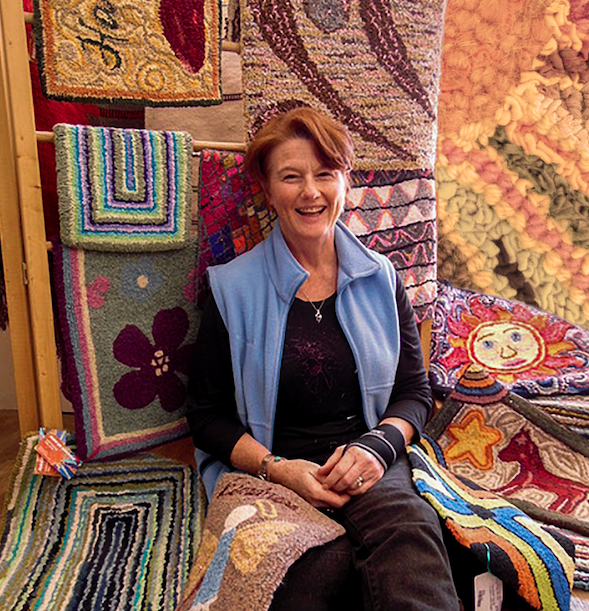
Hi Laura Salamy! Would you mind telling us a little about yourself and your background please?
I’m a 55-year-old wife, mother, and artist. I didn’t start life as any of those things. In high school and college, I was drawn to languages and biology; in fact, my degrees are in biology, French, and biochemistry. For several years I worked in manufacturing ensuring that my employers complied with environmental and worker safety rules. A lay-off led to two other “careers”: running my own editing/writing business and, later, a couple of food pantries.
Around 2003, I filled out a registration form and wrote a cheque to take a community education class for rug hooking. I can’t tell you why. A few years passed quietly; I hooked here and there. I even learned how to do punch needle rug hooking. And then…I was hooking every evening for two and three hours. Creating so many mats, I finally decided to try to sell them to recoup costs. That led to the creation of ‘High on Hooking’.
Somewhere along the way I started teaching at home and at the New Mexico Fibre Arts Center. As well, I currently serve as President of state’s only rug hooking guild. While schooling was my major focus growing up, examples of creative efforts weren’t lacking. My aunt is a painter, a visual artist. She also taught me to crochet. I do a little embroidery as well.
The idea that I should just go ahead and make something, anything, was further impressed upon me by my mother. A talented, pretty much self-taught seamstress, she made much of our clothing. She wasn’t afraid to branch out, to try something new: rug braiding and a cake-decorating business stand out. All while raising five kids. Nothing got in the way of my mother’s industrious self-expression. That’s something I try to emulate.
How did you get into working with textiles?
As mentioned above, I grew up surrounded by sewing paraphernalia, my mother making much of our clothing, even my first wedding dress! That involved a trip to New York City’s garment district and me attaching lots and lots of tiny pearls. Yet, I never got the sewing bug. It was my mother’s happy place, and, frankly, our house wasn’t big enough for two people to sew on the kitchen table.
I crocheted on and off early on but found calligraphy and lettering to be a more compelling pastime. Being detail oriented, I loved it. I even designed my own wedding invitations. After I had my daughter, though, it was difficult to deal with inks and pens and to keep the kid out of it all.
Stumbling into rug hooking when she was still young gave me a creative outlet (other than cooking) that I could pretty much pick up and put down at will. Small projects were easily toted about, and if she got into my yarns and fabric strips, who cared? She couldn’t hurt them or herself.
While I did some hooking and even taught myself to punch hook, I wasn’t yet passionate about hooking. I knew of no shops or guilds near me, though I found some information online. Materials like linen and hand-dyed wool were expensive. I used a quilting hoop rather than a dedicated rug hooking frame for a couple of years which didn’t help.
It was a three-hour workshop with Susan Feller in 2007, that provided the most significant influence to the future of my work. Not only did she teach that rug hooking can be about more than primitive designs and just pulling loops, she provided her own tangible examples that pretty much anything goes! My nascent (at the time) use of alternative fibres was not just acceptable but commendable. The little 10”x10” mat I started in that class: wool strips, wool yarns, t-shirt strips, ribbons, felting, and a button for good measure.
With this encouragement, I found my happy place. Most evenings found me setting down to hook for a good two to three hours as I caught up on some television or a movie. (Sure, my husband gets agitated when I miss something and have to hit the “rewind” button.) Additionally, I regularly hook with friends and guild members in our homes and in public demonstrations.

What inspires your work?
I’m not sure what doesn’t inspire my work. At this point, even my husband Tom is conditioned to see something on a walk, on vacation, in a store and to exclaim, “Hey, wouldn’t that make a good rug?”
Because I offer much of my work for sale, I avoid commercial patterns. Also, my painter-aunt eschewed colouring books when we were kids and made us draw our own pictures to colour. My thought is why should I pay for someone else’s design when I can draw one myself.
In moving to New Mexico and her many Native American tribes, I’ve become more aware of cultural appropriation. It’s become an issue especially with the Zia sun symbol which the state essentially stole from the Zia pueblo (tribe). It flies on the state flag and decorates logos for businesses selling everything from plumbing to used cars. Although I used it to create a couple of rugs, I won’t any longer. I will however, use certain fairly universal petroglyphs which one can see carved into rock formations all over the U.S. Southwest. For instance, I love the spiral motif signifying the circle of life. It’s a compelling theme in artwork.
I don’t know if I have a particular design style, but, because I sell rugs, I will come back to certain images like sunflowers. I love them. At least once each year, I will hook a sunflower table runner/bench cover.
The Boucherouite rugs of Morocco have had a big influence on me. I particularly appreciate that they’re woven with discarded textiles. Last year I finished a large floor rug, “Big Boucherouite.” It measures about 49 inches by 52 inches. It was hooked almost completely with old bed sheets, woven and knit. The design is a bit too regimented to be truly Boucherouite whereby the weaver seems to start with one design and/or colour scheme only to move into another one on a whim. I’m hoping to try another one soon with a real “devil may care” attitude.
My thought is that when you look around at the world and nature, take in museums and all kinds of art, read a poem, when you’re available to most anything around you, there’s an infinite source of inspiration.
Can you tell us about your creative process, what steps do you take when starting a new project?
My creative process for most rugs is pretty consistent. If I have an inkling of what I’m going for, I might collect pictures and drawings on the subject matter, do some additional research. After that I’ll do some sketching, see how close I get to my mental vision. The sketches might be rather different from what’s in my head, and that’s often perfectly fine. I’m open to “what can be.” This also helps to ensure that I don’t copy someone else’s work that I might have seen and buried deep inside my brain. Or at least in a Pinterest folder.
If it’s a precise design, I might draw it onto paper then transfer it onto my monk’s cloth backing. Most often, however, I make use of a pencil and water and/or air soluble “magic” pens to draw right onto the backing. Certainly, because the monk’s cloth has a regular weave, I’ll measure and draw geometrics directly on as well.
At this point, unlike many rug hookers and because I rarely whip the edges of my rugs, I like to hand sew cotton twill tape – AKA, rug binding – to the entire periphery of the rug. The binding will provide a clean finish to the mat and protect the edges, especially if it’s to be used on the floor. Sewing it on ahead of hooking, allows me to hook right up to the binding and ensures that none of the backing will show.
Finally, it’s hooking time! My main and favourite tools include a Nancy Miller pencil hook and a Puritan rug frame. Other than a small, collapsible wooden frame that I recently picked up for travel, I’ve only used a Puritan all these years. It’s low tech with few moving parts, so nothing breaks. Puritan frames were all made in Franklin, Massachusetts, which is where I used to live, so my choice was not a coincidence. Unfortunately, they’re no longer made, but every now and again I acquire a used one for student use.
After the hooking’s complete, I steam the mat and cut off the excess backing. All that’s left then is to tack down the monk’s cloth and hem it all with the binding tape. Voilà.

How do you go about selecting your colour combinations?
Sometimes I see a colour combo that strikes my fancy and will work a rug around it. With my sunflowers, I like to change up the background; I’ve used reds, blues and greens. Recently, I’ve taken to replacing the yellows and golds of the flowers themselves with more fanciful turquoises and purples.
The reality is that I rarely “colour plan” as I understand the term. I’ll have some sense of the colours I want to use and go from there. I’m pretty fluid about it, and if I do get stuck, I’ll ask a friend or two for their opinions.
For me, rug hooking is all about playing with colour. That’s what makes it my happy place.
Where do you source your fabric from?
Up-cycling raw materials is a priority for me. To that effect, most of the fabrics that I use – t-shirts, old bed sheets, other textiles – come from the thrift store or from friends. Once you tell someone that you can use something in your art that they throw away or donate, sacks of stuff show up on your doorstep.
While my preference is to make something beautiful and useful from “throw-aways,” I’m not averse to using virgin fabrics and yarns. Wool is a lovely and pretty sustainable fibre; certain projects are better served using it. For instance, a friend was taken with a portrait of my dog hooked using t-shirts and fanciful, unrealistic colours. She commissioned a portrait of her own dog Daisy but wanted it in wool and more realistic colours. The narrow wool strips made for a richly coloured and detailed Daisy.
Unfortunately, I appear to have developed a bit of a wool dust allergy. With so many fibres available, however, it’s not a huge problem. Other folks with more severe wool allergies should never allow the condition to keep them from rug hooking.
Other favourite fibres are hand-dyed velvets and silk sari yarn. Since the latter is technically recycled, it’s a win for me!

What do you enjoy most about working with textiles?
As mentioned above, colour is what drives my love of textiles. A rug (or a quilt or a shawl) can be a simple abstract or geometric; it can be a complicated floral pattern, but what draws me most to a mat – my own or someone else’s – is the feeling the colours evoke.
After colour, it’s texture. Depending on how I pull a strip or t-shirt or bed sheet – folded or full – I’ll get a loop that’s more or less crinkly. (Wool has more structural integrity, so the loops typically “bloom” flat.) That’s part of the fun. It might not even make a difference to the rug’s design, but it lets me mix it up from project to project.
The textures of textiles like hooked rugs draw one in. You can’t help but want to touch them. Because I do public demonstrations, especially for kids, it’s always fun to watch their eyes widen when I encourage them to touch my work, maybe pull a few loops. “Hey, it’s meant to be walked on!” So many other art forms, including textiles like quilts and embroidery, would be harmed by the oils and dirt on our hands.
I’ll also say that I find rug hooking – and crocheting and embroidery too – “low maintenance.” Most projects are portable. Set-up and clean-up are extremely easy which is great if you have children.

Which other textile artists do you love? Are there any that inspire you, past or present?
Most of the hookers that I really like tend to be less “traditional” hookers. They inspire me to continue on my own “less than traditional” path which is, ironically, quite traditional when one takes into account rug hooking’s unpretentious beginnings.
As mentioned earlier, Susan Feller of Artwools Studio has been a BIG influence. She continues to experiment with rug hooking, incorporating it and other handcrafts into her work thus “connecting traditional craft with contemporary experiences.” Having remained in contact since that class in 2007, Susan has shown me that in rug hooking, as in all art, it’s good to try new things, to combine techniques, and to hook outside the lines. And to never apologise for that.
Laura Kenney, also of Nova Scotia, creates whimsy and story in her rugs. She’s not afraid to tackle darker and even political topics. See her “Judy” rugs.
I’ve long admired Deanne Fitzpatrick of Nova Scotia since finding her years ago online. Her hooking style is unique and her designs charming, full or colour and movement. She made hooking mixed fibres – strips, yarn, and then jersey – cool, even if they are all wool.
Although I don’t quilt, I can appreciate the art. (We have five quilt guilds here in Albuquerque!) Works by Betty Busby, coincidentally from New Mexico, and Karen Kamensky really draw me in given their colour and frequent subject matter close to my heart: biology.
While I took a class to learn the basics of hooking, for years I worked in a vacuum. The Internet provided some information and instruction, but not nearly like what’s available today. Gradually, community developed, especially on Facebook, where folks were happy and willing to share tips and inspirational photos. Today I favour Instagram which allows me to see what other hookers and punchers are doing and to easily follow who and what inspires them and me.
Have you ever experimented with using unconventional materials?
As mentioned previously, I’ve used unconventional materials for most of my career. Fortunately, the hooking world is becoming more accepting of them.
Although I took a beginner’s class, at the end, the teacher just kind of sent us on our way. I knew of no local resources other than the Puritan frame sold locally where they had some linen backing and a bit of wool. While I learned about monk’s cloth online and purchased it that way, buying nice wool was an expensive proposition. I eventually decided to try yarn. I wish I’d known about rug weight yarn because those first two wool yarn rugs took a l-o-n-g time.
That experience ultimately led me to the bulkier rug yarn. More online sleuthing revealed Amy Oxford’s punch needle and books. With them, I taught myself to punch. In 2008, I was lucky enough to take a four-day open workshop with Amy. It revealed my self-taught sins and improved my technique.
Even as I punched, I concentrated on “rug hooking proper.” I’d visit my local thrift store to find the wool skirts and other garments talked about in Rug Hooking Magazine. But there just weren’t that many. Let’s face it, in the last couple of decades, the world’s stopped wearing so much wool, certainly good wool. One day, looking at all the used clothing in the place, a thought popped into my head: t-shirts. They were plentiful and came in all sorts of colours.
I started mixing all kinds of fibres together in rugs, depending on what I was going for in the design: wool, t-shirts, yarns, bathing suits and running tights, silk scarves and blouses, jeans, and ribbons. Later, I added bed sheets to the mix. Like wool, they and t-shirt rugs can withstand foot traffic, though certainly not quite as robustly. I tell people to put them under a bench or in front of the fireplace. In the case of a wall hanging, anything goes, even buttons, jewels, and bits of hardware.
I use alternative materials because: 1) it’s a priority for me to up-cycle throw-aways, to do my part for the environment, and 2) I’d be bored to tears if every rug I hooked was limited to one or two materials. Currently, at least 90% of my rugs are hooked using something other than wool.

Do you have a favourite piece you’ve created so far?
People are always asking how I can sell my rugs given the time and effort spent creating them. Simple: It’s all about the process. I’m going to hook, and I’m going to hook mostly every day. Who knows why, but rugs will happen. I started trying to sell them to recoup some of the costs: monk’s cloth, hooks, a frame, fibres, a cutter, and so on.
And once I’m done with a rug, I’m really done with it. As I’m finishing the hooking, my mind’s moving onto the next rug. I do take several photographs of my mats; that way I can enjoy them again and occasionally make a similar one.
That being said, I’ve appreciated some rugs more than others. An early table runner/bench cover is rather rustic, done up mostly in wool, but I incorporated some sparkly ribbon. Folks have wanted to buy it, but it’s one of the few I’ve kept for myself.
I won’t sell a reproduction of a painting my daughter did when she was little. And “Tynan,” a colourful t-shirt portrait of one of my Welsh Springer spaniels, is something I love and am quite proud of.
My other favourite is another table runner/bench cover, my first influenced by the Moroccan Boucherouite rugs. It was hooked with bed sheets, and I love the oranges and how they meld with the other colours. The properties director for the television show Better Call Saul purchased. (The show is set in and filmed in New Mexico.) Unfortunately, she later decided that is wouldn’t “fit in” with a character’s office, so last I heard, it’s sitting in a Sony warehouse in California. I wish they’d just asked to borrow the piece.

What are you currently working on? Are you able to share any ‘in-progress’ photos?
I’m currently finishing up a piece that will hopefully be featured in a book. Another rug I hooked was included in Karen Miller’s Eyes Open to the World: Memories of Travels in Wool (though it was hooked with t-shirt not wool!). She’s now writing a new book on motherhood and asked if I and others might want to submit a piece to be included. Yes!
Because I’m also in need of rugs that can “travel” to demonstrations and such, I’m also working on a semi-circle rug hooked with bed sheets. Something pretty and practical.
What’s next for you in terms of textile projects?
Because I have an Etsy shop and sell at various events and venues throughout the year, I’m always hooking something to boost my inventory. If I’m lucky, I might pick up a commission or a repair job here and there.
I also like to create at least one “artsy-fartsy” type of piece each year, something that I can enter into art or fibre art shows. Last year, my “Memory of Water” was juried into a show up in Los Alamos that dealt with our dearth of water here in the high desert of New Mexico. It was hooked completely from plastic bags.

What advice would you give someone looking to get into textile art?
If asked, I think that I’d tell someone to get the barebones basics of a technique down and then start experimenting. It’s like writing, once you know and respect the rules, you can break them. In my case with rug hooking, early on I was hesitant to join other rug hookers, even after I found some near my home; I assumed they wouldn’t accept my t-shirt creations as “real” rug hooking. Truthfully, some hookers still don’t. But rug hooking was originally done using whatever clothes were too worn to pass down to the 8th or 9th kid.
It was born in poverty, something women did with a bent nail “hook” to warm their bare or even dirt floors before mass-market carpet came into existence. That’s the real tradition of rug hooking, not the expensive hand-dyed wools and even more dear cutters and frames. Not that those things don’t have their place. But there’s room for us all.
While I teach, I’m not a certified McGown teacher. I limit my teaching to beginners, often those women who see my use of old textiles and find it compelling enough to try it themselves. They rarely have experience or preconceived notions about rug hooking. Hooking’s easy; it’s one “stitch.” Anyone can draw or trace a flower or a quilt square onto a backing Then it’s just a little practice till you make a mug rug or a table runner or anything you like.

Where can people find out more about you and your work?
I am active online on several platforms, I have shared them below:
I also have an article that came out in Rug Hooking Magazine. It’s a review of how I began hooking with bed sheets and other alternative fibres and how I created the “Big Boucherouite.”

Thank you so much Laura Salamy! It’s been great getting to know you! 🙂
If you’ve enjoyed our Q&A with Laura Salamy and would like to be the first to see future Q&As with artists and rag ruggers, why not join our Rag Rug Community on Facebook, follow us on Instagram. Or join our fortnightly newsletter here. Additionally, for more textile work, why not check out the gorgeous work of another one of our Q&A victims, Larry Weyand here.

OR CONNECT WITH US ON SOCIAL MEDIA AT:
Instagram: https://www.instagram.com/raggedlife/
Facebook: https://www.facebook.com/raggedliferagrugs/
Pinterest: https://www.pinterest.co.uk/raggedlife/
Twitter: https://twitter.com/raggedlife
As always, happy rag rugging!
Elspeth x





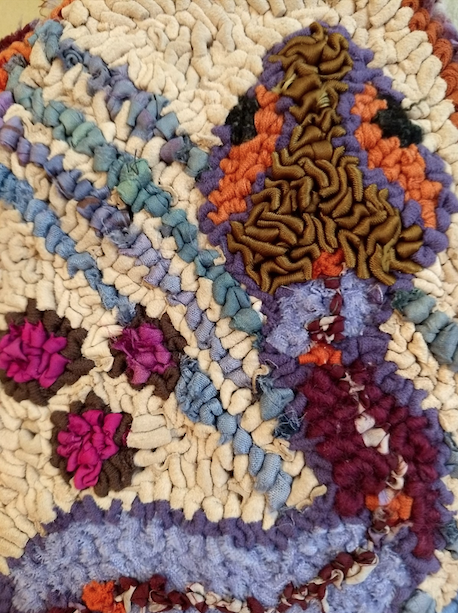


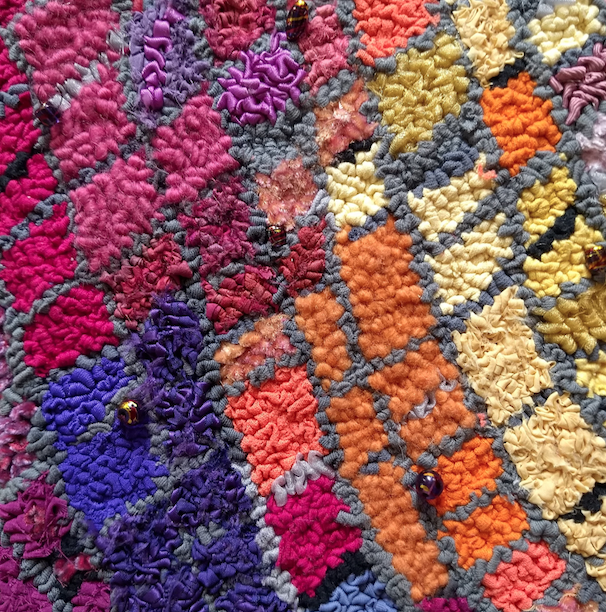


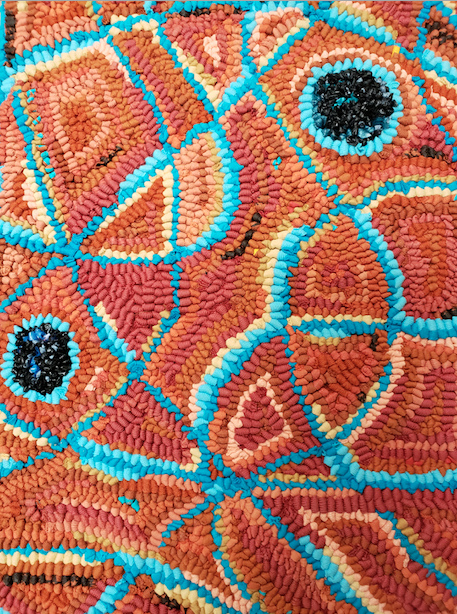
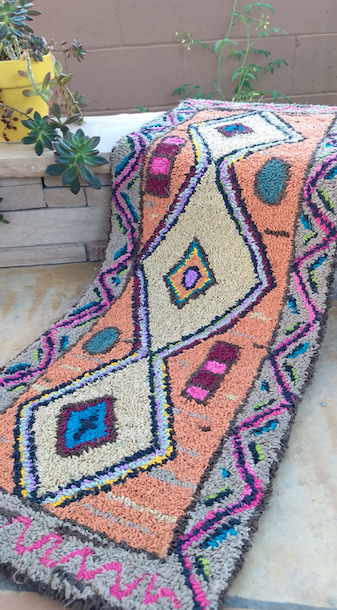


[…] Or, for more textile work then why not check out the incredible work of another one of our Q&A victims, Laura Salamy here. […]